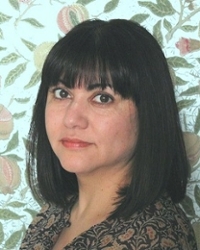Larissa Mendoza Straffon
Guest researcher
- Name
- Dr. L. Mendoza Straffon
- Telephone
- 071 5272727
- l.mendoza.straffon@fsw.leidenuniv.nl
- ORCID iD
- 0000-0001-7352-1999

Fields of interest
Prehistoric Art, Art Theory
Evolutionary approaches to the Humanities
Research
Results from evolution-oriented studies seem to indicate that abstract and symbolic thought, as well as their material manifestation in the form of art, seem to be omnipresent human traits. On this basis, it can be said that these must have somehow represented an evolutionary advantage for our genus. If so, what were the benefits of having art that made it selected for? A number of answers worth exploring have recently been proposed by evolutionary psychology and neurobiology, particularly relating to the correlation of art and perception, memory and language.
The implementation of an evolutionary adaptive approach provides a much needed strong theoretical basis for aesthetic studies, while a biosocial multidisciplinary methodology will help construct a broad account of the origins and evolution of art. For this reason, this project will focus on relevant research on evolutionary disciplines, regarding the social and physical processes that intervene in art making and perception.
The main arguments of this project revolve around four basic presuppositions; 1) Art and aesthetics are an adaptive behaviour characteristic of
Homo sapiens; 2) The appearance and development of symbolic behaviour in our species has had a specific role in our evolution; 3) Art and aesthetics were retained because they are evolutionarily advantageous; and, 4) Art always serves a function in human society. Also, several scenarios of the adaptive function of art and aesthetics will be analyzed here, mainly art as sexual signalling, art as cognitive enhancer and art as social binding.
Finally, by clustering all Pleistocene art into one analytical category, I expect to be able to outline a scheme of the evolution of art up to the Upper Palaeolithic period. In addition, I will look into the possibility of finding content and form universals, patterns and correlations in early art, taking into consideration whatever knowledge we have of the natural and social context within which it was created.
The expected conclusion will optimistically consist of a logical and holistic explanation for the beginnings and development of human art practices and an integrating model for the interpretation of Pleistocene art.
Curriculum Vitae
September 2007–present; PhD Researcher at Leiden University.
2005–2007; Research Assistant in the archaeological projects “Means of Graphic Communication among the Post-Palaeolithic Societies of Catalonia”, and “Biodiversity and Hunter-Gatherer Societies in Quaternary Mexico”, directed by Dr Ramon Viñas of the Institut Catala de Paleoecologia Humana i Evolucio Social in Tarragona, Spain.
2004-2005 Master of Arts in Archaeology, University of Leiden; with specialisation in European Prehistory.
1997-2001 Bachelor of Arts in Archaeology, Escuela Nacional de Antropologia e Historia, Mexico City. Graduated with honours.
Publications
“The Painted Chamber in the Archaeological Complex of Cuicuilco, Mexico City”,
International Newsletter on Rock Art, 2007 no. 47; co-author
“La cueva del Porcelano. Un conjunto rupestre de la sierra de San Francisco, B.C.S.”;
Revista Cuicuilco 2001 no. 20; co-author
“Art rupestre de la Chaine Montagneuse de San Francisco: La Grotte Porcelano, B.C.S. (Mexique)”,
International Newsletter on Rock Art, 2001 no. 29, co-author
Guest researcher
- Social & Behavioural Sciences
- Psychology
- Cognitive Psychology
- Straffon L.M., Perea-García J.O., Blaauwen T. den, Kret M.E. & Mendoza Straffon L. (2025), Traces of intentionality: balance, complexity, and organization in artworks by humans and apes, Topics in Cognitive Science : .
- Groot B. de, Gorr N.D., Kret M.E., Rieffe C., Tsou Y.T. & Straffon L.M. (2023), Development and preliminary validation of a questionnaire to measure parental support for drawing, Thinking Skills and Creativity 47: 101228.
- Mendoza Straffon L., Agnew G., Desch-Bailey C., Berlo E. van, Goclowska G. & Kret M.E. (2022), Visual attention bias for self-made artworks, Psychology of Aesthetics, Creativity, and the Arts : .
- Groot B. de, Gorr N.D., Kret M.E., Rieffe C.J., Tsou Y. & Mendoza Straffon L. (2022), Development and preliminary validation of a questionnaire to measure parental support for drawing, Thinking Skills and Creativity 47: 101228.
- Kret M.E. & Straffon L. (2018), Reply to Crivelli et al.: The different faces of fear and threat. Evolutionary and cultural insights, Journal of Human Evolution 125: 193-197.
- Mendoza Straffon L. (10 September 2014), Art in the Making: The evolutionary origins of visual art as a communication signal (Dissertatie. Leiden University Centre for the Arts in Society (LUCAS), Faculty of Humanities, Leiden University). Supervisor(s) and Co-supervisor(s): Zijlmans K. & Damme W. van, MacDonald K.
